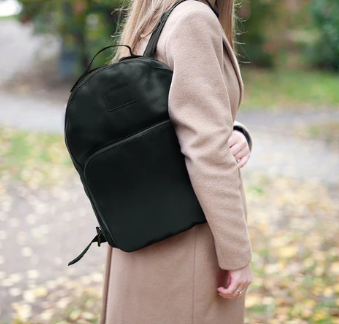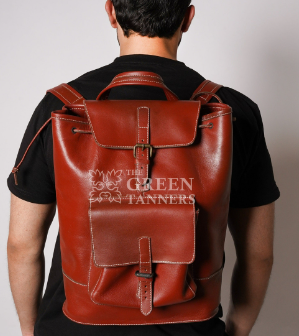Introduction to leather bags and their popularity
Leather bags. Just the mention of these words conjures up images of timeless elegance, sophistication, and undeniable luxury. Whether it’s a sleek tote, a stylish crossbody, or a classic briefcase, leather bags have long been coveted by fashion enthusiasts and professionals alike. But what is it about leather that makes it the epitome of luxury? In this blog post, we’ll delve into the history of leather and its use in high-end goods, explore the different types of leather used in bags and their unique characteristics, uncover the craftsmanship involved in creating top-notch leather pieces, discuss why they are considered status symbols, shed light on sustainable practices within the industry, offer tips for maintaining your beloved bag’s luxurious quality…and even present alternatives to traditional leather options.

The history of leather and its use in luxury goods
Leather has been a prized material for centuries, known for its durability and luxurious appeal. Its history dates back thousands of years when early civilizations discovered the versatility of animal hides. From ancient Egypt to the Roman Empire, leather was highly valued and used for various purposes.
In the Middle Ages, leather became even more sought after as it symbolized wealth and social status. Nobles would adorn themselves with finely crafted leather garments and accessories, showcasing their elite standing in society. This association between leather and luxury continues to this day.
As time passed, artisans began experimenting with different tanning methods to improve the quality and texture of leather. Vegetable tanning emerged as a popular technique, using natural materials like tree bark to create supple yet sturdy hides. This process not only enhanced the longevity of leather but also gave it a distinct aroma that is often associated with high-end products.
With advancements in technology, new types of leather were introduced into the market, each offering unique characteristics. Full-grain leather is considered the finest quality as it retains its natural grain pattern and ages beautifully over time. Top-grain leather is slightly sanded or buffed to remove imperfections while maintaining its durability.
Craftsmanship plays a crucial role in creating exquisite leather goods. Skilled artisans meticulously cut patterns from carefully selected hides before painstakingly stitching them together by hand or using specialized machines. The attention to detail ensures that every seam is flawless, resulting in an impeccably crafted bag that exudes luxury.
The allure of owning a genuine leather bag lies not only in its aesthetic appeal but also in its exclusivity. Luxury brands carefully source their materials from reputable suppliers who adhere to ethical practices such as responsible farming and sustainable production methods. These efforts ensure that consumers can enjoy their luxurious purchase guilt-free.

The different types of leather used in bags and their characteristics
When it comes to leather bags, one of the most important factors to consider is the type of leather used. Different types of leather have distinct characteristics that can greatly impact the overall look and feel of a bag.
One popular type of leather used in luxury bags is full-grain leather. This type of leather is known for its durability and natural beauty. It retains the original grain pattern and imperfections, giving each bag a unique and rustic charm. Full-grain leather also develops a rich patina over time, further enhancing its luxurious appeal.
Another commonly used type of leather is top-grain leather. Unlike full-grain leather, top-grain has been sanded or buffed to remove any imperfections or blemishes on its surface. However, it still maintains its strength and durability while offering a more refined appearance.
For those looking for an even more supple and buttery texture, lambskin or sheepskin may be the ideal choice. These leathers are incredibly soft to the touch and often used in high-end designer bags due to their luxurious feel.
Exotic leathers such as python, crocodile, or ostrich skin are also highly sought after for their unique patterns and textures. These rare materials add an element of exclusivity to any bag they adorn.
It’s important to note that each type of leather requires different care instructions to maintain its quality over time. Regular cleaning with specialized products and conditioning can help preserve the natural oils in the leather, keeping it soft and preventing cracks or wrinkles from forming.
By understanding the different types of leathers available in luxury bags, you can make an informed decision based on your preferences for aesthetics, durability, texture, and maintenance requirements.
The craftsmanship that goes into making a high-quality leather bag
Craftsmanship is the heart and soul of a high-quality leather bag. It takes skilled artisans years to perfect their craft and create these luxurious accessories. Every step of the process requires meticulous attention to detail, from selecting the finest hides to hand-stitching each seam.
The journey begins with choosing the right type and grade of leather. Full-grain leather, known for its natural markings and durability, is often preferred for its rich patina that develops over time. Top-grain leather, with a slightly sanded surface for a smoother appearance, is another popular choice.
Once the leather has been selected, it goes through a series of treatments to enhance its strength and character. Tanning is one such crucial process that involves treating animal skins with natural or synthetic compounds to prevent decay while retaining their suppleness.
Next comes cutting and shaping the pieces that will make up the bag’s body and components. This delicate task requires precision tools and expert hands to ensure accurate measurements and clean edges.
Assembling all these pieces then becomes an intricate dance between craftsmanship and design. Skilled artisans carefully stitch together every panel using traditional techniques like saddle stitching or machine stitching where appropriate.
Details such as hardware placement, zippers, pockets, straps are meticulously added during this stage ensuring both functionality and aesthetics are seamlessly integrated into the final product.
Why leather bags are considered a status symbol
When it comes to accessories, leather bags have long been associated with luxury and status. But what is it about these bags that makes them such coveted symbols of prestige? Let’s delve into the factors that contribute to the allure of leather bags as a status symbol.
Leather has always been regarded as a premium material. Its durability, richness, and natural beauty set it apart from synthetic alternatives. When you carry a genuine leather bag, you’re immediately signaling your discerning taste and appreciation for quality craftsmanship.
Moreover, the exclusivity factor cannot be overlooked. High-end designer brands often use top-grade leathers sourced from reputable tanneries. These materials are carefully selected and processed to ensure their superior quality. Owning a leather bag from one of these prestigious labels instantly elevates your style game and showcases your ability to invest in timeless fashion pieces.
Additionally, leather bags exude an air of sophistication that sets them apart from other materials like canvas or nylon. The inherent elegance of leather adds a touch of refinement to any outfit or occasion – whether it’s a business meeting or an evening out on the town.
Furthermore, the longevity of leather also contributes to its status symbol status. A well-crafted leather bag can last for decades if properly cared for, making it not just an accessory but an investment piece worth splurging on.
Tips for caring for your leather bag to maintain its luxurious quality
Proper care and maintenance are essential to ensure that your leather bag retains its luxurious quality. Here are some tips to help you keep your prized possession looking immaculate.
1. Regular Cleaning: Start by removing any surface dirt or dust with a soft, dry cloth. Avoid using harsh chemicals or cleaning agents as they can damage the leather. Instead, opt for a mild soap solution or specialized leather cleaner and gently wipe down the bag.
2. Conditioning: Leather is prone to drying out over time, so it’s important to regularly condition it with a high-quality leather conditioner. Apply a small amount onto a clean cloth and gently massage it into the bag in circular motions. This will help restore moisture and prevent cracking.
3. Storage: When not in use, store your leather bag in a cool, dry place away from direct sunlight. Stuffing it with acid-free tissue paper will help maintain its shape while also absorbing excess moisture.
4. Avoid Water Damage: Protect your leather bag from water by applying a waterproof spray specifically designed for leathers before using it outdoors on rainy days.
5. Professional Help: If you notice any significant stains or damages that you cannot handle yourself, seek professional assistance from a reputable leather expert who can provide proper restoration services tailored to your specific type of leather.
By following these simple yet effective tips, you can ensure that your luxury leather bag remains in pristine condition for years to come!
Conclusion
In conclusion, leather bags stand as enduring symbols of luxury, craftsmanship, and status, echoing their historical significance. With a variety of leathers and meticulous hand craftsmanship, each bag tells a unique story. As the fashion industry embraces sustainability, ethical practices in leather sourcing gain prominence. Today, owning a premium leather bag signifies not just style but also a commitment to responsible choices. To preserve the luxurious quality, proper care is crucial. While traditional leather holds its allure, the rise of cruelty-free alternatives caters to those seeking ethical and diverse options in the world of fashion.



